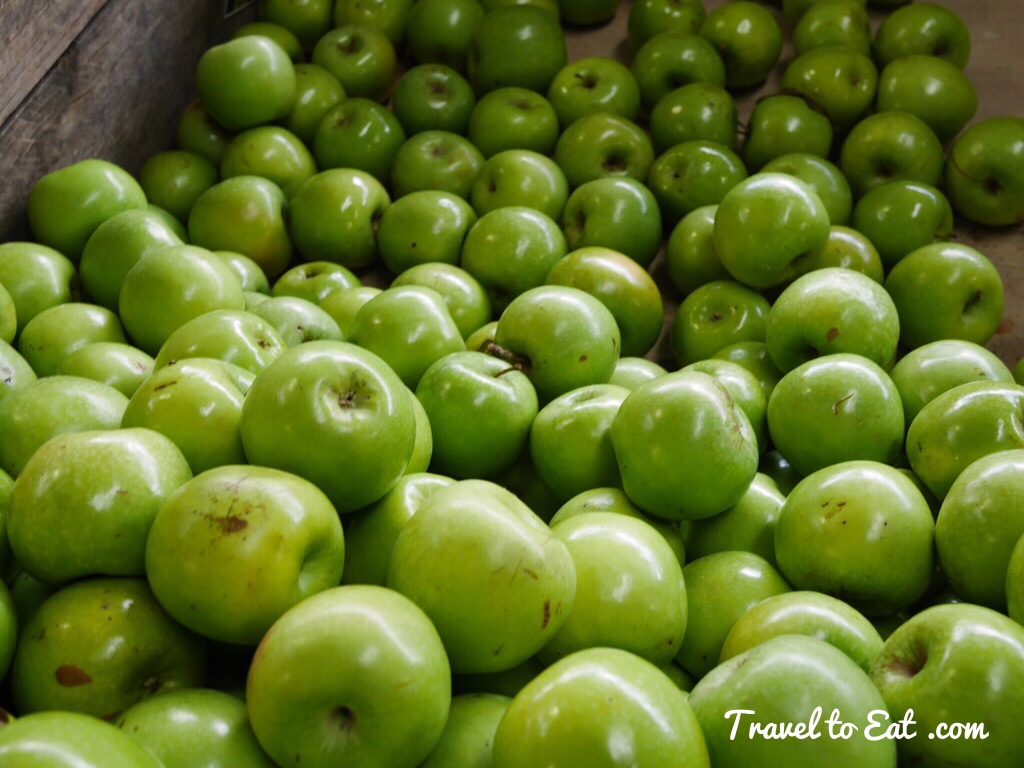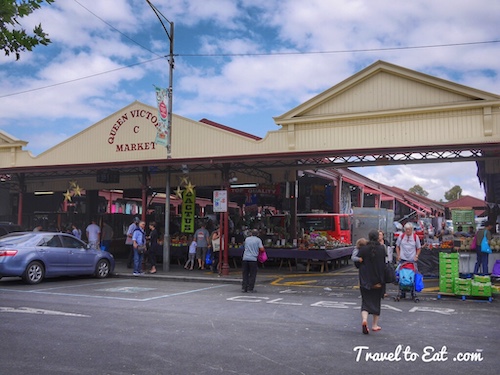
Also known affectionately as ‘Vic Market’ or ‘Queen Vic’, the Queen Victoria Market has been the heart and soul of Melbourne for more than a century. A historic landmark spread over two city blocks, it’s a vibrant and bustling inner-city Market where you can shop for everything from Australian fruit and vegetables, and local and imported gourmet foods, to cosmetics, clothing and souvenirs. Because this is such a large market, I have divided this post into fruits and vegetables. Obviously this is the fruit portion and while the fruit looks familiar, the varieties are sometimes very different. I have also chosen to include the histories of these fruits, a guide to our past and the Neolithic revolution.
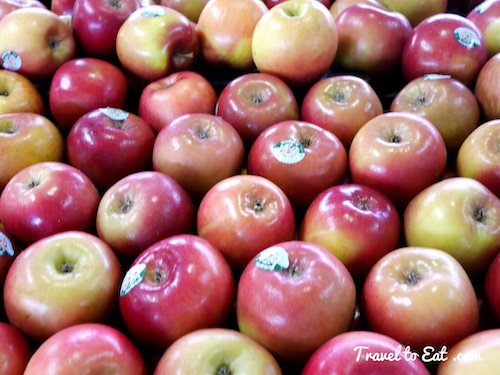
The Fuji apple is an apple hybrid developed by growers at the Tohoku Research Station in Fujisaki, Aomori, Japan, in the late 1930s, and brought to market in 1962. It originated as a cross between two American apple varieties—the Red Delicious and old Virginia Ralls Genet (sometimes cited as “Rawls Jennet”) apples. Its main characteristic is the lovely pink speckled flush over a yellow-green background. It is also crisp and juicy, with dull white flesh which snaps cleanly. The flavor is predominantly sweet, very refreshing (especially if slightly chilled), but not particularly outstanding. In Japan and the US, Fuji apples continue to be an unrivaled best-seller. Japanese consumers prefer the crispy texture and sweetness of Fuji apples (which is somewhat reminiscent of the coveted Nashi pear) almost to the exclusion of other varieties and Japan’s apple imports remain low.
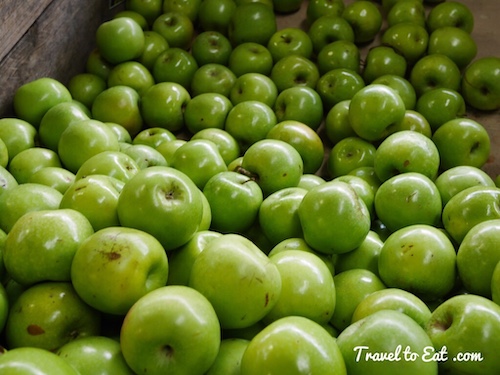
It is not widely known but the Granny Smith apple was developed in Australia. In 1868, Maria Ann Smith, then 69 years old, found a seedling growing by a creek on her property. She believed that the seedling had grown from French crab apples (it is now believed that the apple is a cross between the Malus sylvestris, or European Wild Apple, and the M. domestica, or domestic apple). Granny Smith began to cultivate this new apple tree. Yet another local, Edward Gallard, developed a large crop of them from cuttings from the first tree and continued to do so annually until his death in 1914. The apples became widely popular in Australia and New Zealand. Displayed at the Castle Hill Agricultural and Horticultural Show in 1891, “Smith’s seedling” won the prize for best cooking-apple. In 1895, Granny Smith Apples were being produced at the Government Experimental Station in Bathurst, New South Wales on a large scale. Soon after, they were included on the list of fruits suitable for export put out by the Department of Agriculture. The apples were introduced to Great Britain in 1935. This particular apple is a relatively recent addition to the United States, where it was introduced in 1972 by Grady Auvil of the Auvil Fruit Company.
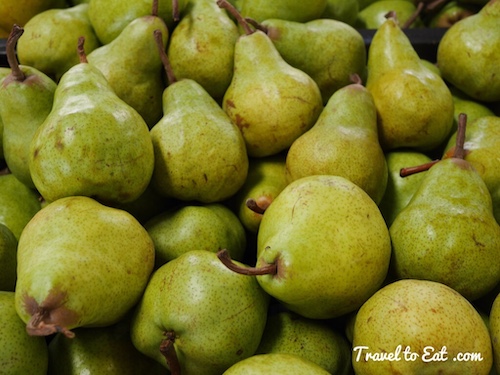
Although there are finds of pears in sites in Neolithic and Bronze Age European sites, “reliable information on pear cultivation first appears in the works of the Greek and the Roman writers.” Theophrastus, Cato the Elder, and Pliny the Elder all present information about the cultivation and grafting of pears. About 50% of pears sold in the US are Williams’ Bon Chrétien (England, circa 1770; a summer pear commonly called Bartlett in the US and Canada, and Williams elsewhere). I personally love the winter Bosc pear for its crunchy texture and sweet flavor. Originally developed in Australia, the Packham pear is also widely grown in Chile, Argentina, and South Africa. It was cultivated in Australia in 1896, by Charles Packham and with its initial growth and popularity was named Packham’s Triumph. Primarily grown in the Southern Hemisphere, Packham pears are shipped worldwide and can be found in home gardens and at a few farmer’s markets in the United States.
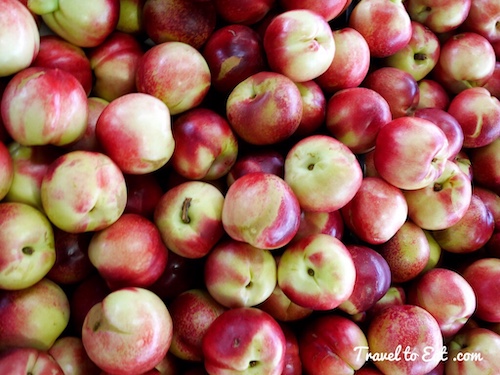
Nectarines, or ‘nectar of the Gods’, are a variety of peach with a smooth yellow, orange or red skin and either white or yellow juicy flesh. Originating in China some 4000 years ago, nectarines can either be eaten firm and crunchy or allowed to ripen to become soft, juicy and lower in acid.
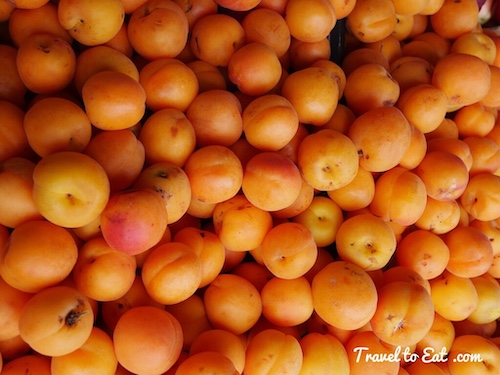
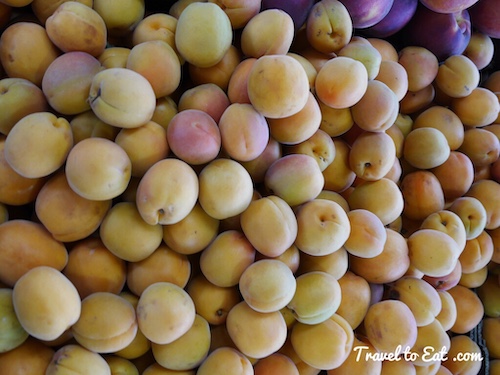
Although its botanical name Prunus persica refers to Persia (present Iran) from where it came to Europe, genetic studies suggest peaches originated in China, where they have been cultivated since the early days of Chinese culture, circa 2000 BC. Peaches were mentioned in Chinese writings as far back as the 10th century BC and were a favoured fruit of kings and emperors. The origin of the apricot is disputed. It was known in Armenia during ancient times, and has been cultivated there for so long, it is often thought to have originated there. Its scientific name Prunus armeniaca (Armenian plum) derives from that assumption. Apricots have been cultivated in Persia since antiquity, and dried ones were an important commodity on Persian trade routes. Its introduction to Greece is attributed to Alexander the Great; later, the Roman General Lucullus (106–57 BC) also would have imported some trees – the cherry, white heart cherry, and apricot – from Armenia to Rome.
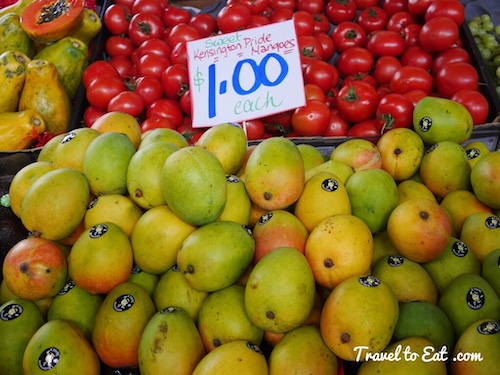
The Kensington Pride Mango (also known as the Bowen) is a soft medium-sized (300g – 600g) mango with golden flesh with a sweet, tangy flavour and a rich orange skin tinged with a pink or red blush, the most popular variety grown in the sub-tropical and tropical regions of Australia, making up 70% of all trees planted.
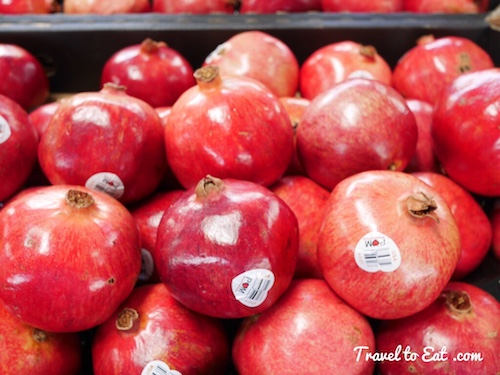
One of the oldest cultivated fruit trees in the world, the pomegranate has appeared in Greek mythology and hymns dating back to the 7th century BC, a feat not matched by any other berry or fruit. In fact, there are some schools of thought that suggest the pomegranate was in fact the “forbidden fruit” in the Bible, rather than the humble apple. The pomegranate is considered to have originated in the region from Iran to northern India.
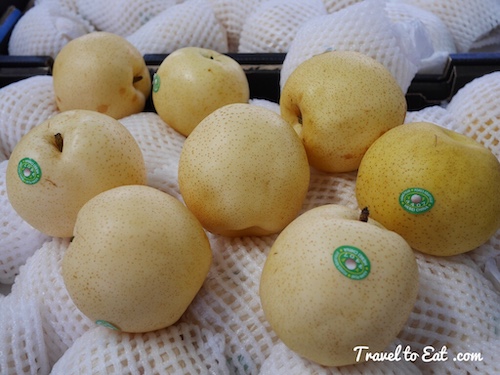
Pyrus pyrifolia is a pear tree species native to China, Taiwan, Japan, and Korea. The tree’s edible fruit is known by many names, including: Asian pear, Chinese pear, Korean pear, Japanese pear, Japanese Apple Pear, Taiwan pear, and sand pear. Along with cultivars of P. × bretschneideri and P. ussuriensis, the fruit is also called the nashi pear. Cultivars derived from Pyrus pyrifolia are grown throughout East Asia, and in other countries such as Australia, New Zealand, and the United States.
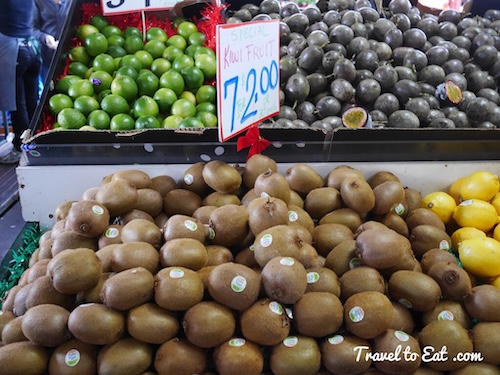
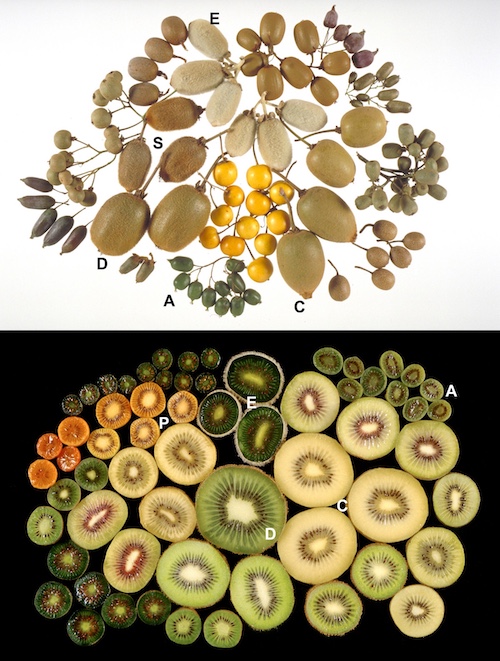
Almost all kiwifruit sold belong to a few cultivars of fuzzy kiwi (Actinidia deliciosa): ‘Hayward’, ‘Blake’, and ‘Saanichton 12’. They have a fuzzy, dull-brown skin, and bright-green flesh. Kiwifruit is native to northern China. Other species of Actinidia are native to India, Japan, and southeastern Siberia. Cultivation of the fuzzy kiwifruit spread from China in the early 20th century to New Zealand, where the first commercial plantings occurred. You almost never see the golden or black varieties of this fruit.
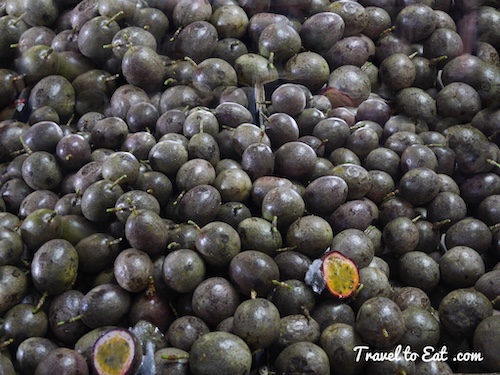
Passiflora edulis is a vine species of passion flower that is native to Brazil, Paraguay and northern Argentina. Its common names include passion fruit (US), passionfruit (UK and Commonwealth), and purple granadilla (South Africa). In Australia and New Zealand, where it is called “passionfruit”, it is available commercially both fresh and tinned. It is added to fruit salads, and fresh fruit pulp or passion fruit sauce is commonly used in desserts, including as a topping for pavlova (a regional meringue cake) and ice cream, a flavouring for cheesecake, and in the icing of vanilla slices. A passionfruit-flavoured soft drink called Passiona has also been manufactured in Australia since the 1920s. It can be used in some alcoholic cocktails.
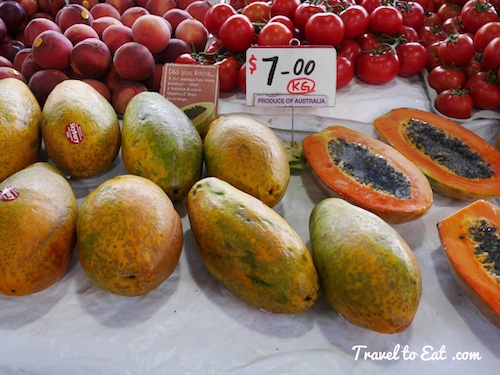
The papaya, papaw, or pawpaw is the fruit of the plant Carica papaya, the sole species in the genus Carica of the plant family Caricaceae. It is native to the tropics of the Americas, perhaps from southern Mexico and neighbouring Central America. It was first cultivated in Mexico several centuries before the emergence of the Mesoamerican classical civilizations. There are two types of papayas, Hawaiian and Mexican. The Hawaiian varieties are the papayas commonly found in supermarkets. These pear-shaped fruit generally weigh about 1 pound and have yellow skin when ripe. The flesh is bright orange or pinkish, depending on variety, with small black seeds clustered in the center. Hawaiian papayas are easier to harvest because the plants seldom grow taller than 8 feet. Mexican papayas are much larger the the Hawaiian types and may weigh up to 10 pounds and be more than 15 inches long. The flesh may be yellow, orange or pink. The flavor is less intense than that the Hawaiian papaya but still is delicious and extremely enjoyable. They are slightly easier to grow than Hawaiian papayas. A properly ripened papaya is juicy, sweetish and somewhat like a cantaloupe in flavor, although musky in some types. The fruit (and leaves) contain papain which helps digestion and is used to tenderize meat. The edible seeds have a spicy flavor somewhat reminiscent of black pepper.
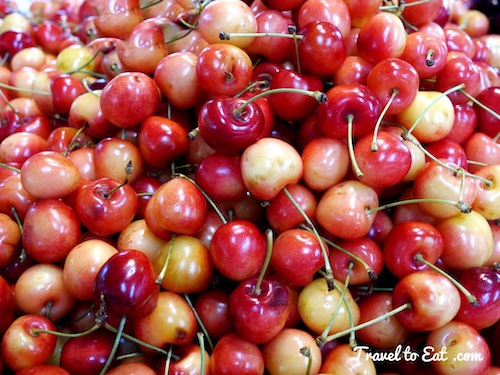
Napoleon is a delicious cherry, one of the best of all the Bigarreaus, whether regarding its great size, beautiful appearance, or particular richness of flavour. The Napoleon cherries skin is pale yellow dotted with red, but as it becomes perfectly ripe these dots are lost in a beautiful deep red cheek, which overspreads the side exposed to the sun, leaving only a few yellow spots. The flesh is very firm, white, and reddish at the stone, abounding in a very rich, sweet, and aromatic juice. The Royal Ann or Royal Anne (also called Napoleon and Queen Ann) is a variety of cherry, similar in appearance and taste to the Rainier cherry (one of my favorite cherries). It is both eaten fresh and used in making pies and Maraschino cherries.
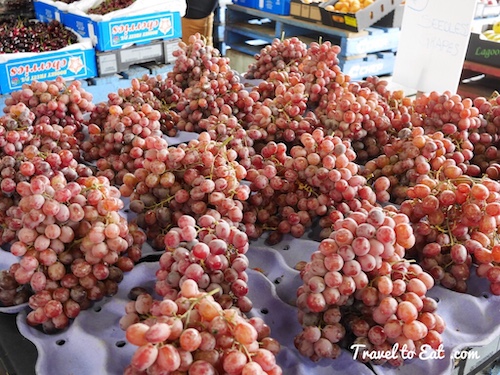
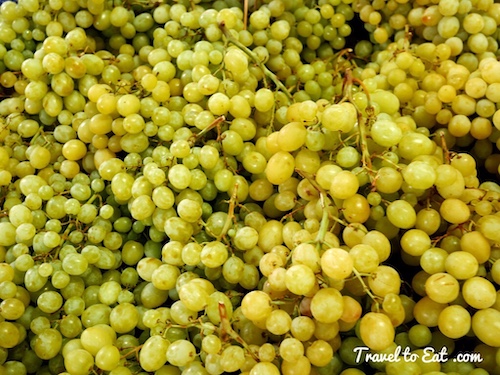
Red Globe Grape was developed from the Emperor variety in 1980. This variety is very popular in Asian markets. Bunches are large, conical and well filled. The grapes bear big, pinkish-red, very large (round) plum sized berries containing large seeds. The berries are crisp and crunchy and the flavour is quite delicate with a fleshy pulp. It is a major variety in Australia. Thompson Seedless is an oval-berried, pale to amber green, seedless variety of grape widely cultivated worldwide for table use and for drying as raisins. This variety is very sweet and produces thin clusters of large berries. Thompson Seedless is famous for its large, long bunches. This is currently the number one variety grown in Australia. The variety of banana best known to us today is the Cavendish, named after Englishman William Spencer Cavendish, the 6th Duke of Devonshire. In Australia, bananas are grown in both tropical and subtropical regions. This ensures the industry is diverse in terms of the geographical location of banana farms, farming practices, the size and type of farms that grow bananas, the varieties of bananas grown and their flavor.
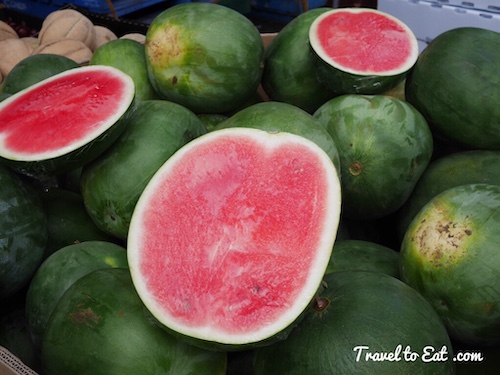
The watermelon plant has been cultivated in Egypt since at least the 2nd millennium BC and by the 10th century AD had reached India and China. It later spread into southern Europe and on into the New World. In the 7th century, watermelons were being cultivated in India and by the 10th century had reached China, which is today the world’s single largest watermelon producer. Moorish invaders introduced the fruit into Europe and there is evidence of it being cultivated in Córdoba in 961 and also in Seville in 1158. It spread northwards through southern Europe.
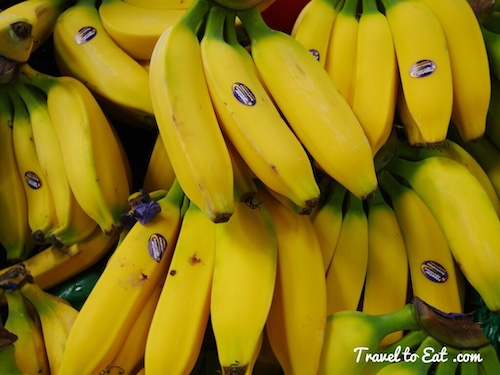
Bananas are believed to have originated up to 10,000 years ago and some scientists believe they may have been the world’s first fruit. The first bananas are thought to have grown in the region that includes the Malaya Peninsula, Indonesia, the Philippines and New Guinea. From here, traders and travelers took them to India, Africa and Polynesia. There were references to bananas from 600 BC when Buddhist scriptures, know as the Pali Canon, noted Indian traders travelling through the Malaysian region had tasted the fruit and brought plants back with them. In 327 BC, when Alexander the Great and his army invaded India, he discovered the banana crop in the Indian Valleys. After tasting this unusual fruit for the first time, he introduced this new discovery to the Western world. Chinese migrant communities introduced the first bananas to Australia. Chinese migrants are thought to have brought the first banana plants with them to Australia in the 1800s – firstly in the early to mid 1800s to Carnarvon in Western Australia and then to north Queensland in the 1870s.
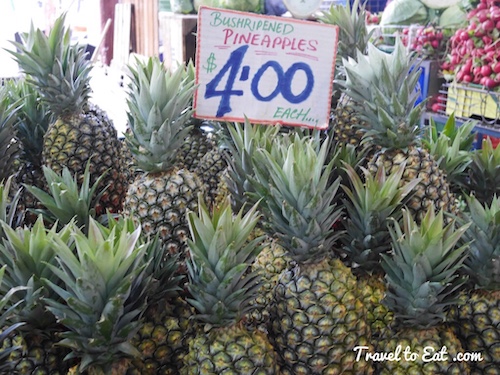
The pineapple is indigenous to South America and is said to originate from the area between southern Brazil and Paraguay; however, little is known about the origin of the domesticated pineapple considered the Paraná–Paraguay River drainages to be the place of origin of A. comosus. The natives of southern Brazil and Paraguay spread the pineapple throughout South America, and it eventually reached the Caribbean, Central America and Mexico, where it was cultivated by the Mayas and the Aztecs. Columbus encountered the pineapple in 1493 on the leeward island of Guadeloupe. He called it piña de Indes, meaning “pine of the Indians,” and brought it back with him to Europe, thus making the pineapple the first bromeliad to leave the New World.
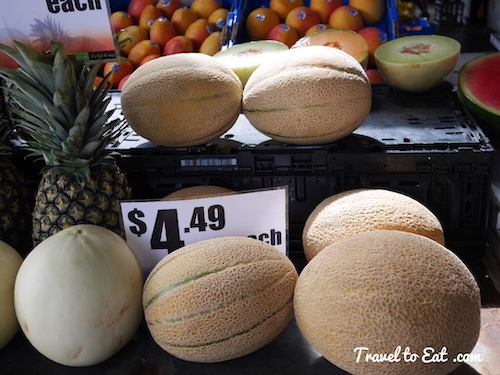
The cantaloupe originated in Iran, India and Africa; it was first cultivated in Iran some 5000 years ago and in Greece and Egypt some 4000 years ago. The name is derived, via French, from the Italian Cantalupo which was formerly a papal county seat near Rome. Tradition has it that this is where it was first cultivated in Europe, on its introduction from Ancient Armenia. Its first known usage in English dates from 1739 in The Gardeners Dictionary Vol. II by Scottish botanist Philip Miller (1691–1771). Honeydew” is in fact the American name for the White Antibes cultivar which has been grown for many years in southern France and Algeria. In China, honeydews are known as the Bailan melon; they are a locally famous product near Lanzhou, the capital city of Gansu province in China’s northwest. According to Chinese sources, the melons were introduced to China by a Mr. Wallace, who donated melon seeds to the locals while visiting in the 1940s (probably 1944).
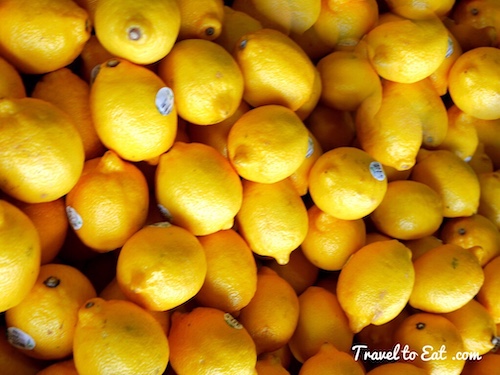
The origin of the lemon is unknown, though lemons are thought to have first grown in Assam (a region in northeast India), northern Burma, and China. A study of the genetic origin of the lemon reported it to be hybrid between bitter orange (sour orange) and citron.
I have gone into excruciating detail about the history of these fruits to illustrate just one thing. The history of food is an indispensable guide to the history of civilization. The food that magically appears on our plates is the result of millenia of evolution and selective breeding. These plants come from ancient times and places that span the globe. Our primate ancestors crossed the globe, against improbable odds and impossible distances, to create the neolithic revolution, eventually resulting in art, architecture, written history and music. That is the real purpose of this blog, to truly understand our history and our future.
References:
Website: http://www.qvm.com.au/
Granny Smith Apples: http://www.todayifoundout.com/index.php/2013/05/granny-smith-apples-are-named-after-a-real-granny-smith/
Packham Pears: http://www.specialtyproduce.com/produce/Packham_Pears_1540.php
Bananas: http://www.australianbananas.com.au/banana-facts/cyclone-yasi

